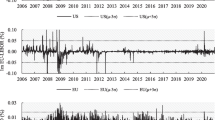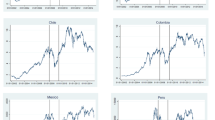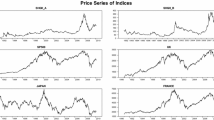Abstract
In this paper, we analyze the jump intensity in the Euro area, Japan, the UK and the US and measure their reactions to the US Federal Reserve meetings together with the country’s own monetary policy meetings. Evidence suggests that the jump intensity in all the markets is highly persistent. Further, the US monetary policy positively impacts the jump intensity in almost all the cases, including in the sub-sample periods found by the structural break test. Moreover, in assessing the joint effects on jump intensities, we find that the US policy dominates the monetary policy of the country itself.


Similar content being viewed by others
Notes
For more details about inference and modelling please refer to Chan and Maheu (2002).
For AR(2)-GARCH (1,1) model the log-likelihoods for FTSE100, Nikkei225, EuroStoxx50, and S&P500 are: −11,550.184, −13,483.983, −11,679.587, and − 25,610.653 respectively. For constant jump intensity model the log-likelihoods for FTSE100, Nikkei225, EuroStoxx50, and S&P500 are −11,391.962, −13,206.336, −11,403.618, and − 25,030.434 respectively. For time-varying jump intensity model (i.e. ARJI) the log-likelihoods for FTSE100, Nikkei225, EuroStoxx50, and S&P500 are −11,378.396, −13,206.336, −11,403.618, and − 24,967.038 respectively (reported in Table 1). Clearly, the time-varying jump intensity model better fits the data in terms of higher log-likelihoods, and hence, is the preferred model for jump intensity for these four stock markets. Detailed estimated results are not reported here for the model without jumps and the constant jump intensity model, but are available upon request from the authors.
We also estimated a model for the Euro Area, Japan, and UK, based on just their own respective monetary policy committee meeting dummies, i.e., without the FOMC dummy. However, results were quantitatively and qualitatively similar to those obtained under Eq.(7a) and Eq.(7b). Hence, these results have not been reported to save space, but are available upon request from the authors.
Results were, however, both qualitatively and quantitatively similar with the contemporaneous FOMC dummy for Japan. Complete details of these results are available upon request from the authors.
We also analysed the role of US jump intensity on the jump intensities of FTSE100, EuroStoxx50 and Nikkei225. Again for Japan, lagged US jump intensity was used. In all cases the effects were positive, with the coefficients being 0.1414 (FTSE100), 0.3296 (EuroStoxx50) and 0.1096 (Nikkei225), and statistically significant at the 1 % level of significance. Complete details of these results are available upon request from the authors.
References
Andersen TG, Bollerslev T, Diebold FX, Vega C (2007) Real-time price discovery in global stock, bond and foreign exchange markets. J Int Econ 73(2):251–277
Apergis N (2015) The role of FOMC minutes for US asset prices before and after the 2008 crisis: evidence from GARCH volatility modeling. Q Rev Econ Finance 55:100–107
Bai J, Perron P (2003) Computation and analysis of multiple structural change models. J Appl Econ 18(1):1–22
Bernanke BS, Kuttner KN (2005) What explains the stock market's reaction to Federal Reserve policy? J Financ 60(3):1221–1257
Blinder A, Ehrmann M, Fratzcher M, De Hann J, Jansen J (2008) Central bank communication and monetary policy: a survey of theory and evidence. J Econ Lit 46:910–945
Bollerslev T (1986) Generalized autoregressive conditional heteroskedasticity. J Econ 31(3):307–327
Bollerslev T, Law TH, Tauchen G (2008) Risk, jumps, and diversification. J Econ 144(1):234–256
Chan WH, Maheu JM (2002) Conditional jump dynamics in stock market returns. J Bus Econ Stat 20:377–389
Ehrmann M, Fratzscher M (2009) Global financial transmission of monetary policy shocks. Oxf Bull Econ Stat 71(6):739–759
French DW, Lynch AA, Yan XS (2012) Are short sellers informed? Evidence from REITs. Financ Rev 47(1):145–170
Gurkaynak R, Sack B, Swanson ET (2005) Do actions speak louder than words? The response of asset prices to monetary policy actions and statements. Int J Central Banking 1:55–93
Hausman J, Wongswan J (2011) Global asset prices and FOMC announcements. J Int Money Financ 30(3):547–571
Kishor NK, Marfatia HA (2013) The time-varying response of foreign stock markets to US monetary policy surprises: evidence from the federal funds futures market. J Int Financ Mark Inst Money 24:1–24
Li J, Li G, Zhou Y (2015) Do securitized real estate markets jump? International evidence. Pac Basin Financ J 31:13–35
Liao Y (2013) The benefit of modeling jumps in realized volatility for risk prediction: evidence from Chinese mainland stocks. Pac Basin Financ J 23:25–48
Marfatia HA (2014) Impact of uncertainty on high frequency response of the US stock markets to the Fed's policy surprises. Q Rev Econ Finance 54(3):382–392
Newey W, West K (1987) A simple positive semi-definite, heteroscedasticity and autocorrelation consistent covariance matrix. Econometrica 55:703–708
Wongswan J (2009) The response of global equity indexes to US monetary policy announcements. J Int Money Financ 28(2):344–365
Acknowledgements
We would like to thank two anonymous referees for many helpful comments. However, any remaining errors are solely ours.
Author information
Authors and Affiliations
Corresponding author
Rights and permissions
About this article
Cite this article
Gupta, R., Lau, C.K.M., Liu, R. et al. Price jumps in developed stock markets: the role of monetary policy committee meetings. J Econ Finan 43, 298–312 (2019). https://doi.org/10.1007/s12197-018-9444-z
Published:
Issue Date:
DOI: https://doi.org/10.1007/s12197-018-9444-z






